MARIANI’S
Virtual
Gourmet
JUNE 2,
2019
NEWSLETTER

"Specially for You" by Zoë Mozert (c. 1946)
❖❖❖
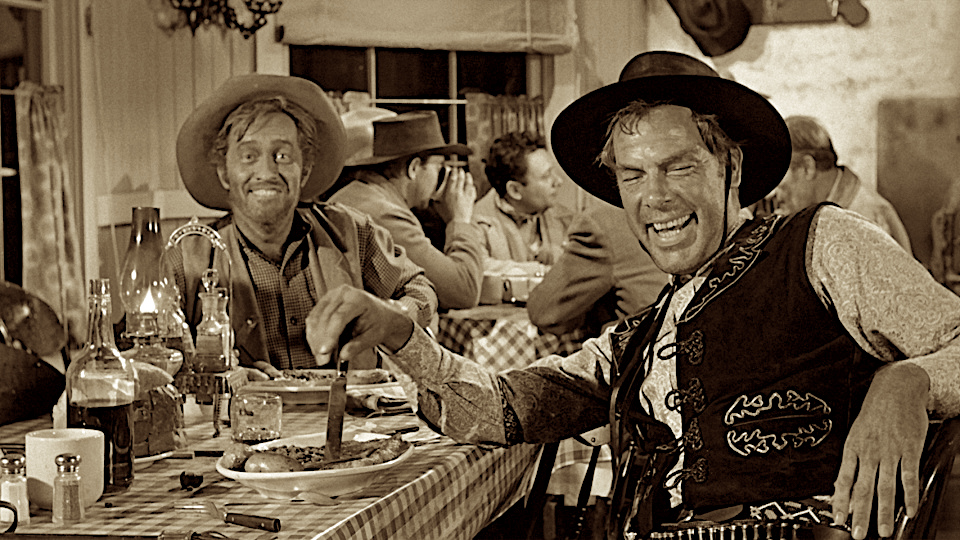
ANNOUNCEMENT: There will be no issue of Mariani's Virtual Gourmet Newsletter next week because Mariani will be eating around Arizona
❖❖❖
IN THIS ISSUE
NORMANDY
By John Mariani
NEW YORK CORNER
BUSTAN
By John Mariani
NOTES FROM THE WINE CELLAR
PLUMPJACK'S BIG CABS
By John Mariani
❖❖❖
NORMANDY
By John Mariani

The American Cemetery at Omaha Beach
I shall write in a moment about the principal reason people from all over the world visit Normandy, but it is important to remark on what a rich and historic region of France it is, apart from the famous D-Day beaches. Indeed, three of France’s greatest artistic sites are here—Giverney, where Claude Monet lived and painted, the Bayeux Tapestry and Mont Saint-Michel.
 I certainly
cannot add anything about the
Normandy landings, this year having its 75th
anniversary, that isn’t extensively covered in
books and guides that
describe every detail of the operation that began
on the morning of June 6,
1944. I
can comment on the
unexpected quiet that pervades this tremendously
popular tourist spot. As at
monuments like New York’s World Trade Center and
Pearl Harbor’s Arizona
Memorial, all you hear is the
wind. It sounds like reverence. It comes in off
the English Channel and rustles
the dunes where those brutish, intimidating German
bunkers (below)
familiar from all
World War II documentaries are still anchored,
their long guns thrust forever
towards
I certainly
cannot add anything about the
Normandy landings, this year having its 75th
anniversary, that isn’t extensively covered in
books and guides that
describe every detail of the operation that began
on the morning of June 6,
1944. I
can comment on the
unexpected quiet that pervades this tremendously
popular tourist spot. As at
monuments like New York’s World Trade Center and
Pearl Harbor’s Arizona
Memorial, all you hear is the
wind. It sounds like reverence. It comes in off
the English Channel and rustles
the dunes where those brutish, intimidating German
bunkers (below)
familiar from all
World War II documentaries are still anchored,
their long guns thrust forever
towards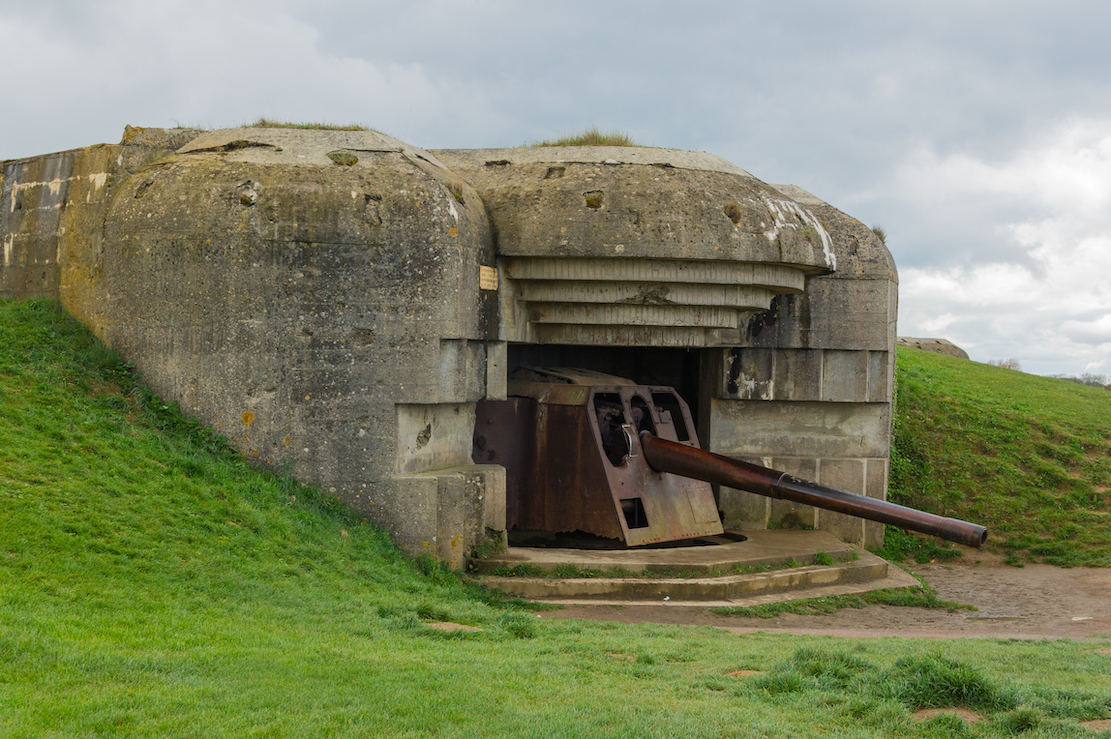 the sea. The
wind blows
through their ruins, too, reminding me of
Shelley’s poem Ozymandias: “Round the decay of that
colossal Wreck, boundless and
bare/ The lone and level sands stretch far away.”
the sea. The
wind blows
through their ruins, too, reminding me of
Shelley’s poem Ozymandias: “Round the decay of that
colossal Wreck, boundless and
bare/ The lone and level sands stretch far away.”
I was also amazed by how close to the Channel’s water were the palisades and slopes, the x-shaped, so-called Czech hedgehog barriers and those fearsome bunkers. It seems the beaches were mere yards in depth, and I understood how so many thousands lost their lives so quickly while struggling to get a foothold in the shifting sand.
And then there are the vast cemeteries with their simple white crosses stretching east and west, north and south, row after solemn row over the soft, well-tended green grass, each marked with the name of a soldier, sailor or airman, a husband, father, son or grandson who gave his life on a day when more than 425,000 Allied and German troops were killed, wounded or went missing. By now, most of the survivors are gone, too.
The visitors centers at the various beaches—Omaha, Sword, Juno, Utah, Gold— are each superbly done, with memorabilia, uniforms and flags, maps, recorded interviews and architecture that respectfully echoes the tenor of the events that happened there.
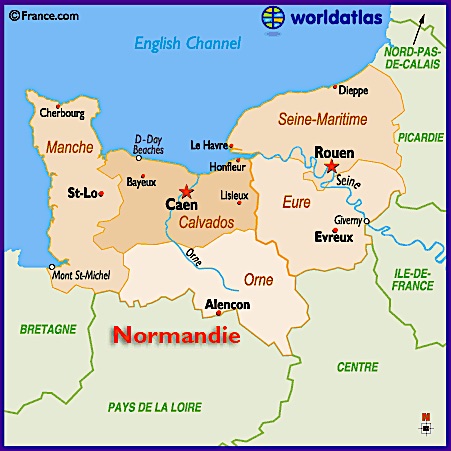 Normandy
takes up a good chunk of northwestern
France, and is largely agricultural, with a
population of 3.5 million. (It’s
astonishing that the region lost
three-quarters of its population during the 14th
century Hundred Years’ War). The
Normans were a formidable
power, once controlling England, Wales, Ireland,
Sicily and other territories.
Joan of Arc was burned at the stake in the Norman
city of Rouen.
Normandy
takes up a good chunk of northwestern
France, and is largely agricultural, with a
population of 3.5 million. (It’s
astonishing that the region lost
three-quarters of its population during the 14th
century Hundred Years’ War). The
Normans were a formidable
power, once controlling England, Wales, Ireland,
Sicily and other territories.
Joan of Arc was burned at the stake in the Norman
city of Rouen.
Among Normandy’s fortifications was the
extraordinary Mont Saint-Michel, which, since the
8th century, has been located
half a mile off shore, at the mouth of the
Couesnon River, whose high tide
would block any attempts to mount an effective
offensive. To
see it from the mainland is like
seeing Kubla Khan’s Xanadu “floating midway on the
waves,” now reached by a
fleet of  shuttle buses that begin at far away
parking lots.
shuttle buses that begin at far away
parking lots.
Back in the 8th century, the bishop of Avranches declared that Michael the Archangel directed him to build a church on the mountain, which was to enclose a Carolingian Benedictine abbey and to be a major point of pilgrimage for Christians from all over Europe. In this century pilgrims are joined by mere tourists—more than 3 million each year—so that once on the island, you are in for a steep walk up clogged narrow streets lined with eateries and souvenir shops selling t-shirts and plastic swords. You’ll find yourself saying “Pardon,” every few feet until you enter the magnificent structure built into the sides of the mountain, clinging so precariously that one section is referred to as “the Marvel.”
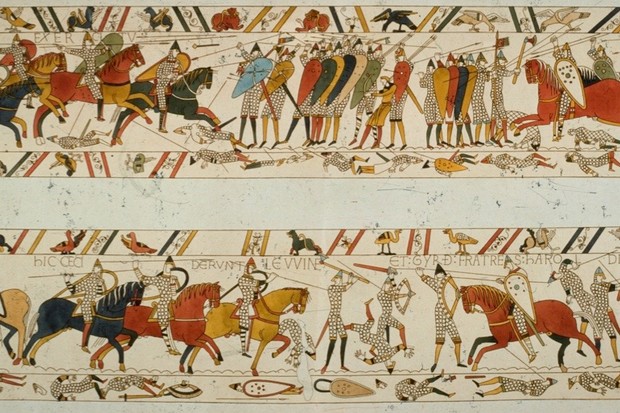 After
visiting the abbey itself, there is added
pleasure in simply strolling over the salt marshes
during low tide, with their
glistening, sandy sweep into the ocean that will
always return to engulf
them.
After
visiting the abbey itself, there is added
pleasure in simply strolling over the salt marshes
during low tide, with their
glistening, sandy sweep into the ocean that will
always return to engulf
them.
Two other sites of old Norman history are the
Bayeux Tapestries (left) in the Musée de la
Tapisserie de Bayeux in Bayeux, and the
Basilica of Saint Thèrése in the town of Lisieux.
Of the first of these there
is nothing quite like it in the world: a 230-foot
embroidered tapestry that
tells the story of the history-changing Battle of
Normandy in 1066 between
William, Duke of Normandy, and Harold of Hastings,
who was killed in action in
the field. Believed to be woven shortly after the
battle and depicted as a
cartoon-like narrative of the battle, the tapestry
also includes
scenes of medieval farm life,
animals and birds, ending with the first known
illustration of Haley’s Comet.
The tapestry has long been regarded as one of the
most important achievements
of western art—evoking the very earliest examples
of the cave paintings of Lascaux
in southern France—and, by the 19th 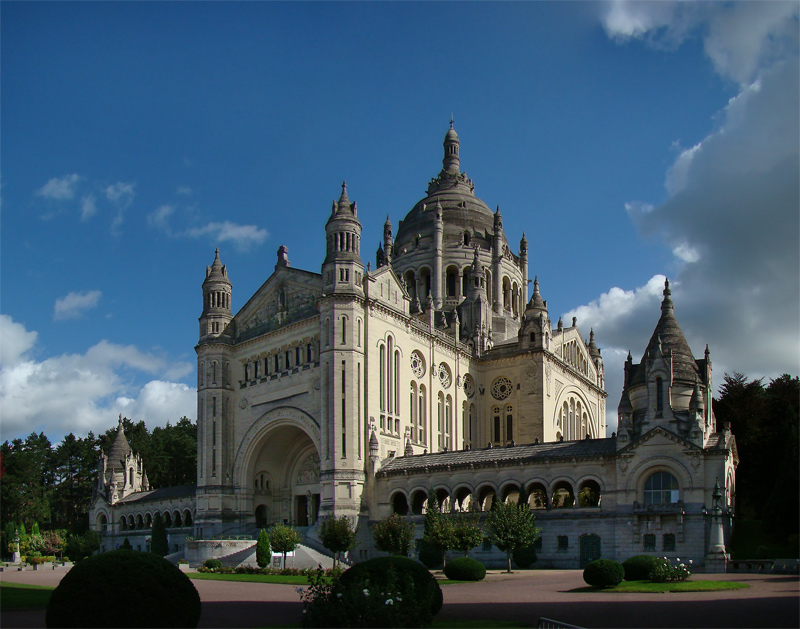 century, travelers already
complained of
the length of the queues to get in to see it. So
will you.
century, travelers already
complained of
the length of the queues to get in to see it. So
will you.
The Basilica of Saint Thèrése is a vast
structure (right),
complete with a large gift shop of mementos, that
seems all out of
character for a Carmelite nun known as the “Little
Flower” for her simple
goodness and piety. As a little girl, quite
sickly, she claimed that the Virgin
Mary appeared to her. After becoming a nun, she
turned her own struggles,
doubts and afflictions into widely read lessons of
humility and endurance that
were admired for their clarity  and
adherence to the true virtues of Christ’s
teachings. Dying of tuberculosis at the age of 24,
she remarked, "I have reached the point of not
being able to suffer any
more, because all suffering is sweet to me."
and
adherence to the true virtues of Christ’s
teachings. Dying of tuberculosis at the age of 24,
she remarked, "I have reached the point of not
being able to suffer any
more, because all suffering is sweet to me."
More than two million visitors each year come to the small city of Lisieux to visit the Basilica—the second largest religious tourist site in France after Lourdes—which opened only in 1954. Its Roman-Byzantine design echoes that of Sacre Coeur in Paris, shaped like a Latin cross, with an interior that stands without columns and is resplendent with colorful mosaics. The crypt below depicts scenes from the saint’s short life.
There is
a great deal more
to see in Normandy, not least Monet’s Giverney,
which I must save for another
time. The region has a long shoreline, a rocky
coast and great access to
seafood. That, too, will be the subject of another
article to come.
❖❖❖
By John Mariani
487 Amsterdam Avenue (between 83rd and 84th Streets)
212-595-5050
Tuna
crudo with radishes
For several years
Bustan,
which means “garden” or “orchard,” was among the
best and most popular ethnic
restaurants on the Upper West Side. Sadly, last
year, the interior was engulfed
by fire, though the lovely outdoor patio (below) was
largely spared. Now re-opened by
owner Tuvia Feldman, Bustan has been restored to
look pretty much the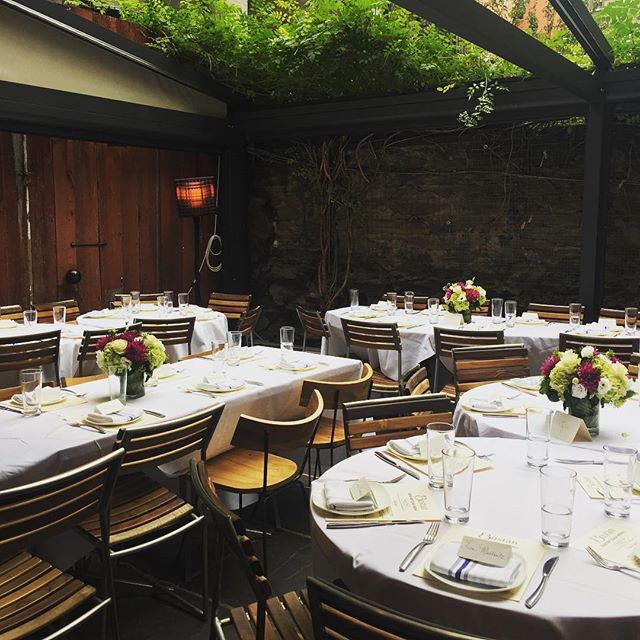 way it
had, and Chef Efi Buliskeria, now joined by Shir
Rozenblatt as pastry chef (below), has
taken what was always wonderful on the menu and
refined and lightened it all
with real finesse.
way it
had, and Chef Efi Buliskeria, now joined by Shir
Rozenblatt as pastry chef (below), has
taken what was always wonderful on the menu and
refined and lightened it all
with real finesse.
The menu is still resolutely
devoted to the flavors and culinary traditions of
North Africa, Italy, Greece
and the Middle East, from mezes
(or mazettim)
to many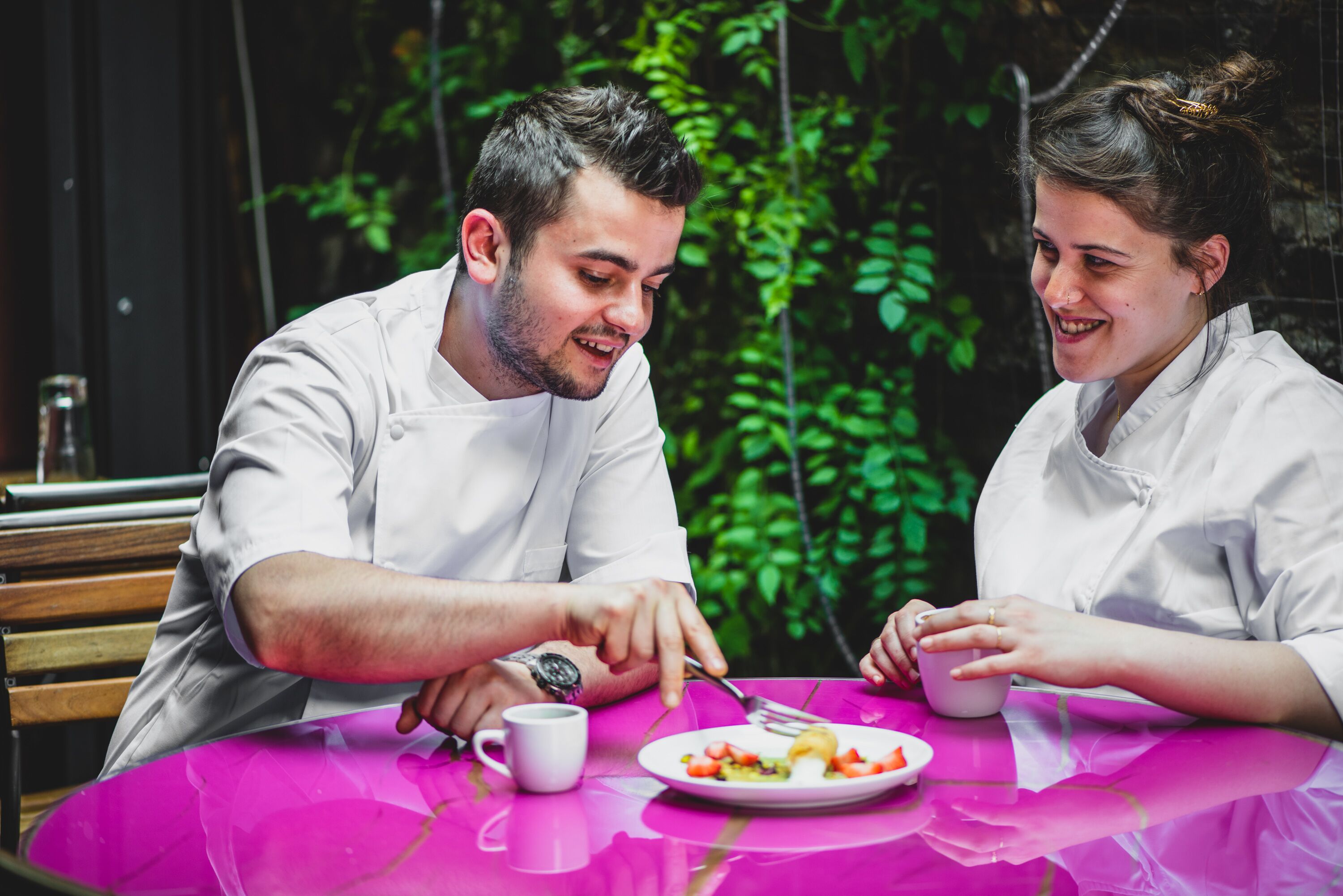 dishes
cooked in a dome-shaped, wood-fired taboon oven.
There
is a short wine and beer list on the back of the
menu, but a far more
extensive and interesting collection is also
available.
dishes
cooked in a dome-shaped, wood-fired taboon oven.
There
is a short wine and beer list on the back of the
menu, but a far more
extensive and interesting collection is also
available.
The long room and bar off Amsterdam Avenue is done in gem-like hues and glowing, lunar-like wall art. It can get loud, especially with the piped-in music, but the patio now opened is currently one of the most genial and quiet oases from the bustle of the neighborhood.
The service staff matches the ambiance in both charm and warmth, and general manager Udi Vaknin seems to be everywhere and at every table’s behest.
 At our table we
ate extensively
from the menu, leaving ourselves in Buliskeria’s
hands to choose, starting with an
array of mezes
($7-$19), beginning
with several spreads that included creamy hummus,
crispy falafel and spiced
feta cheese and tangy yogurt in a pool of pale
golden olive oil.
One of the most distinguishing aspects
of Mediterranean cooking are the puffy, yeasty
breads of a kind Bustan excels
at, and a hot, steamy loaf arrives with the mezes
and is replenished throughout the evening.
At our table we
ate extensively
from the menu, leaving ourselves in Buliskeria’s
hands to choose, starting with an
array of mezes
($7-$19), beginning
with several spreads that included creamy hummus,
crispy falafel and spiced
feta cheese and tangy yogurt in a pool of pale
golden olive oil.
One of the most distinguishing aspects
of Mediterranean cooking are the puffy, yeasty
breads of a kind Bustan excels
at, and a hot, steamy loaf arrives with the mezes
and is replenished throughout the evening.
More substantial appetizers
included a radiant and translucent tuna crudo
with tomato seeds, radish and basil ($16), made
more savory by the exotic
flavor of preserved lemon. 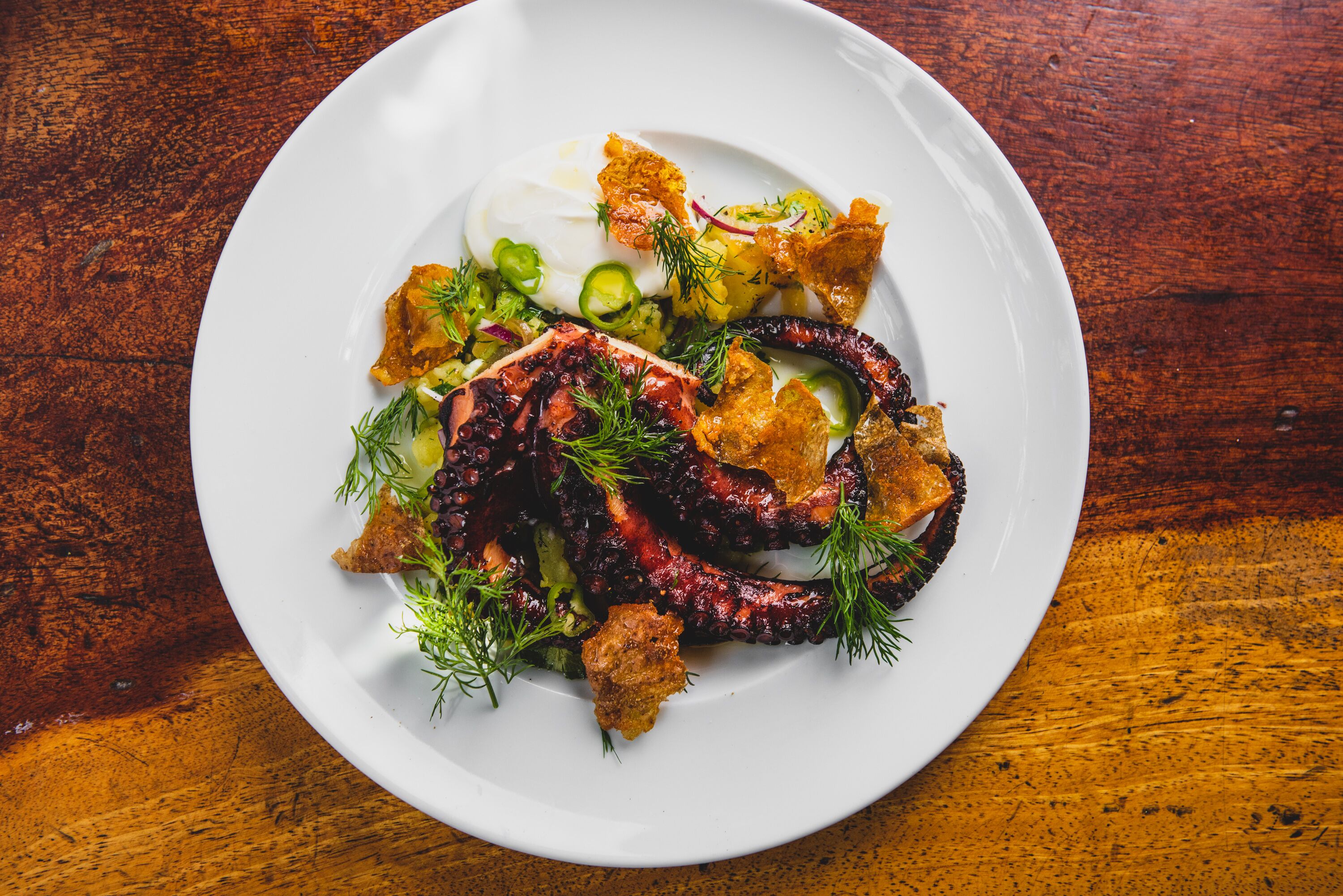 New to
the menu is a wonderful eggplant carpaccio ($14)
with smoky roasted eggplant,
chile peppers, shallots, sesame and herbs. I was
duly impressed by a dish of
sliced tomatoes with feta, shallots, za’atar,
Moroccan olives and fresh herbs ($15), simply
because this is June, when
tomatoes of this sweetness are not in season.
Somehow Buliskeria has managed to find
these at their ripest, which I assume are from a
hothouse, and they are
delicious.
New to
the menu is a wonderful eggplant carpaccio ($14)
with smoky roasted eggplant,
chile peppers, shallots, sesame and herbs. I was
duly impressed by a dish of
sliced tomatoes with feta, shallots, za’atar,
Moroccan olives and fresh herbs ($15), simply
because this is June, when
tomatoes of this sweetness are not in season.
Somehow Buliskeria has managed to find
these at their ripest, which I assume are from a
hothouse, and they are
delicious.
Plump shrimp were grilled and spiked with fiery harissa, coriander and a lemony tzatziki sauce, with herbed frisee on the side ($19). Grilled octopus (right), as you'd expect, is a first rate rendition.
The main courses come in big terracotta casseroles draped with pastry dough that puffs up in the taboon. When the dough is removed, the air is suffused with the flavors of whatever has been cooked inside, like chicken Musakhan with tahini, a dried, salted mango condiment called amba, watercress-basil and sumac-spiced almonds ($27); or a sumptuous seafood stew named chraimeh containing tomatoes, sweet red peppers, chickpeas, coriander and tahini ($29).
T here are,
of course,
kebabs, and one of the best, called halabi,
is made in the taboon
with roasted onions, tomatoes, chile peppers, pine
nuts
and tahini ($31). Needless to say, these dishes
are made to be shared, and at
our table every morsel was lapped up with
pleasure.
here are,
of course,
kebabs, and one of the best, called halabi,
is made in the taboon
with roasted onions, tomatoes, chile peppers, pine
nuts
and tahini ($31). Needless to say, these dishes
are made to be shared, and at
our table every morsel was lapped up with
pleasure.
Do not neglect Rozenblat’s lovely desserts (all $11), which include laila—a coconut cake (left) made with semolina, Malabi cream, crunchy pistachios and strawberries; kisses—not an Arabic word—which is a custard of baked vanilla meringue, Chantilly cream, raspberry sorbet and mixed berries; nemesis, which is a very rich baked chocolate mousse, salted caramel and chocolate pearls, and ice cream.
So, Bustan has risen, phoenix-like, from the ashes and emerged all the better, and now sets a new standard for Mediterranean food for all of Manhattan.
Open for dinner nightly; Fri., Sat. & Sun. for brunch.
❖❖❖
THE BIG CABS
OF PLUMPJACK
By John Mariani
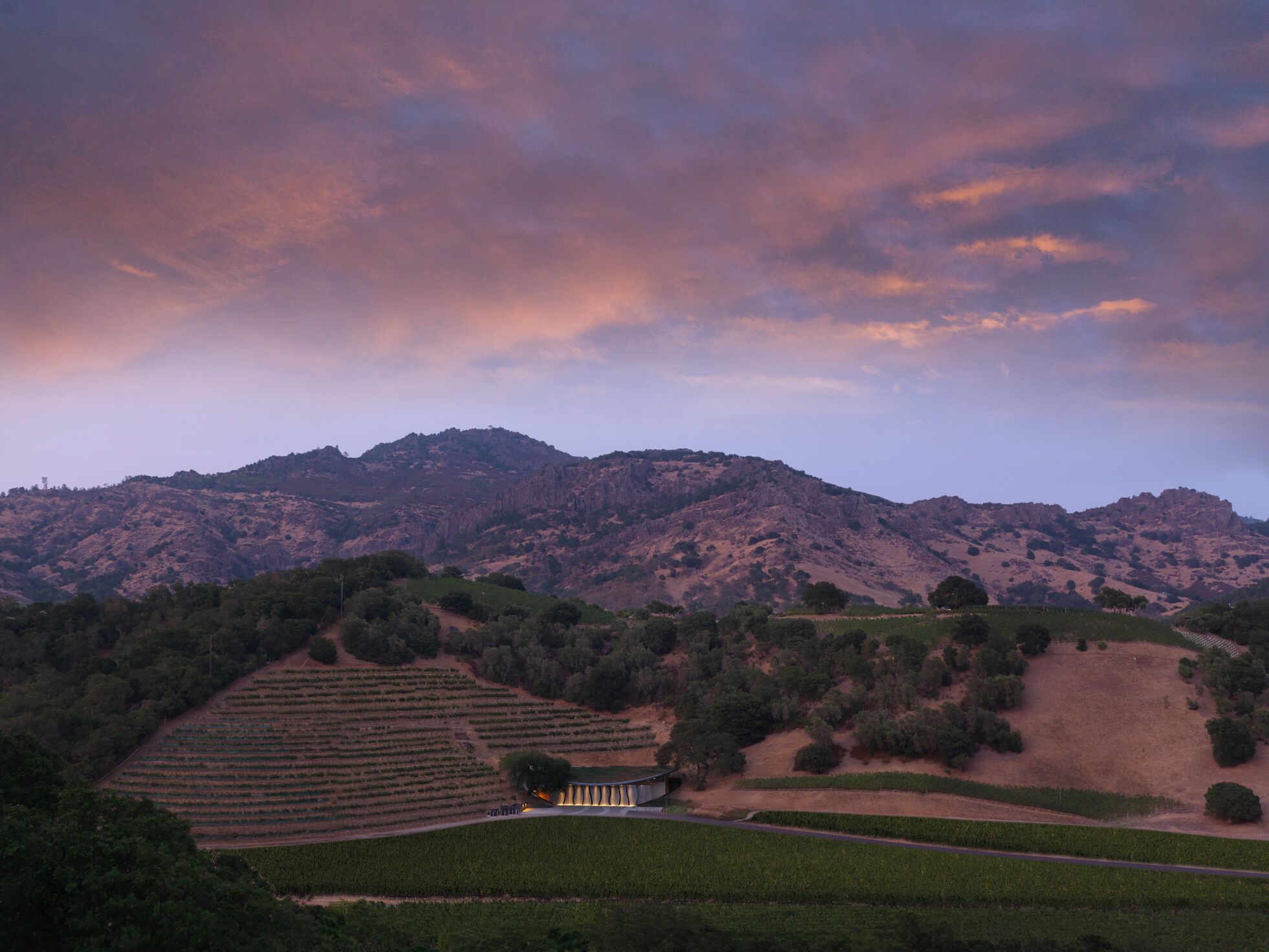
The Odette Winery, Napa Calley
Gordon Getty sings
and writes operas. He also
makes wine, but he’d much rather talk about
music, and he gets positively
exultant about certain composers and their
work.
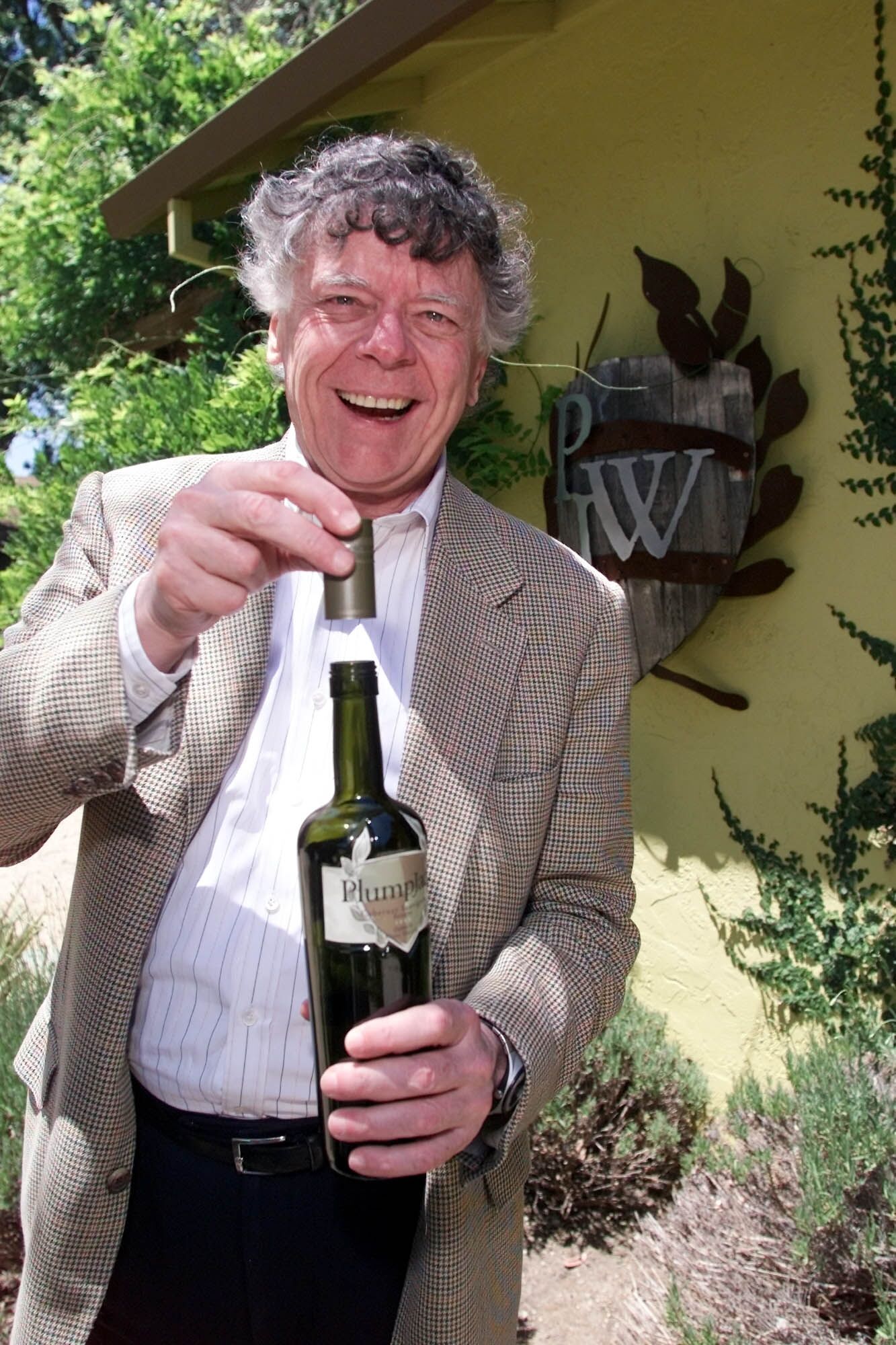 “My God,
Handel’s Messiah?
Can you believe how magnificent
that is! How the music
matches the words from the Bible! ‛And He
shall reign forever and ever! Hallelujah!
Hallelujah!’ Incredible!”
“My God,
Handel’s Messiah?
Can you believe how magnificent
that is! How the music
matches the words from the Bible! ‛And He
shall reign forever and ever! Hallelujah!
Hallelujah!’ Incredible!”
Over dinner at New York’s Benjamin Steakhouse, Getty rhapsodized about his favorite composers and about who’s overrated and underrated—he puts Mozart only “among the top five”—all while enjoying his wines. Wearing a plaid shirt and dark windbreaker, his hair refusing any attempt to comb it, he looked as much like a farmer in from the fields as he did a musician in the throes of composing a new opus.
As the fourth child of oil magnate J. Paul
Getty, Gordon oversaw the company’s vast
holdings after his father’s death in
1976, but clearly his personal interests lay in
classical music, earning a B.A.
in the discipline from the San Francisco
Conservatory of Music. Ten years later
he sold Getty Oil to Texaco for $10 billion,
making him the world’s richest man
at the time. (Forbes
currently ranks
him at 212th richest, with a $2.1 billion net
worth.) Since then he has been a
canny investor as well as a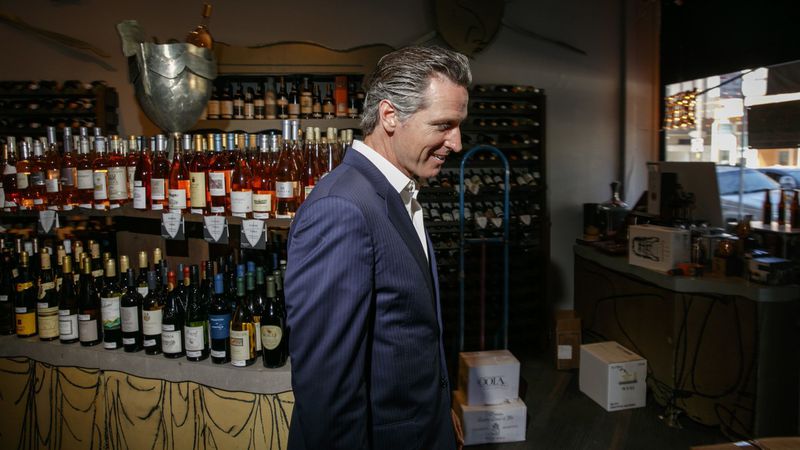 generous philanthropist, underwriting the San
Francisco Opera and the Russian
National Orchestra through the Ann and Gordon
Getty Foundation.
generous philanthropist, underwriting the San
Francisco Opera and the Russian
National Orchestra through the Ann and Gordon
Getty Foundation.
All the while he has also been composing operas, choral and chamber works, orchestral and piano works, with several performances and recordings to his credit.
And then there’s the wine. An initial investment by Getty in Mt. Eden Winery, located on 53 acres of vineyard land in Oakville, soured quickly, so he bought out the other investors and brought in his lifelong friend, entrepreneur Gavin Newsom (right), later mayor of San Francisco, two-term Lieutenant Governor of California and now Governor. Together they founded The PlumpJack Group in 1992 and opened the PlumpJack wine store, then expanding to include a boutique hotel, three restaurants and, in 1997, PlumpJack Winery (replacing Mt. Eden).
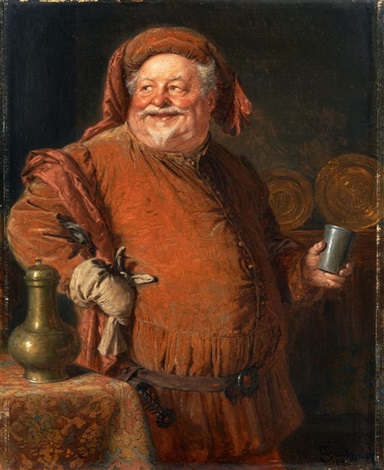 The name PlumpJack refers to
Shakespeare’s fat
Jack Falstaff and reflects, as the winery
owners say, his “fun-loving, down-to-earth
disposition ... rivaled by his
fierce loyalty to Prince Henry V, with whom he
shares more than a few goblets
of sack (wine) at the local tavern. We pay
allegiance to our world-class
vineyard by crafting high-quality wines that
honor the land, and we celebrate
the convivial spirit of our namesake with
their inviting, approachable style.”
The name PlumpJack refers to
Shakespeare’s fat
Jack Falstaff and reflects, as the winery
owners say, his “fun-loving, down-to-earth
disposition ... rivaled by his
fierce loyalty to Prince Henry V, with whom he
shares more than a few goblets
of sack (wine) at the local tavern. We pay
allegiance to our world-class
vineyard by crafting high-quality wines that
honor the land, and we celebrate
the convivial spirit of our namesake with
their inviting, approachable style.”
In
1999 Newsom and Getty brought in John Conover (below) as
General Manager and partner,
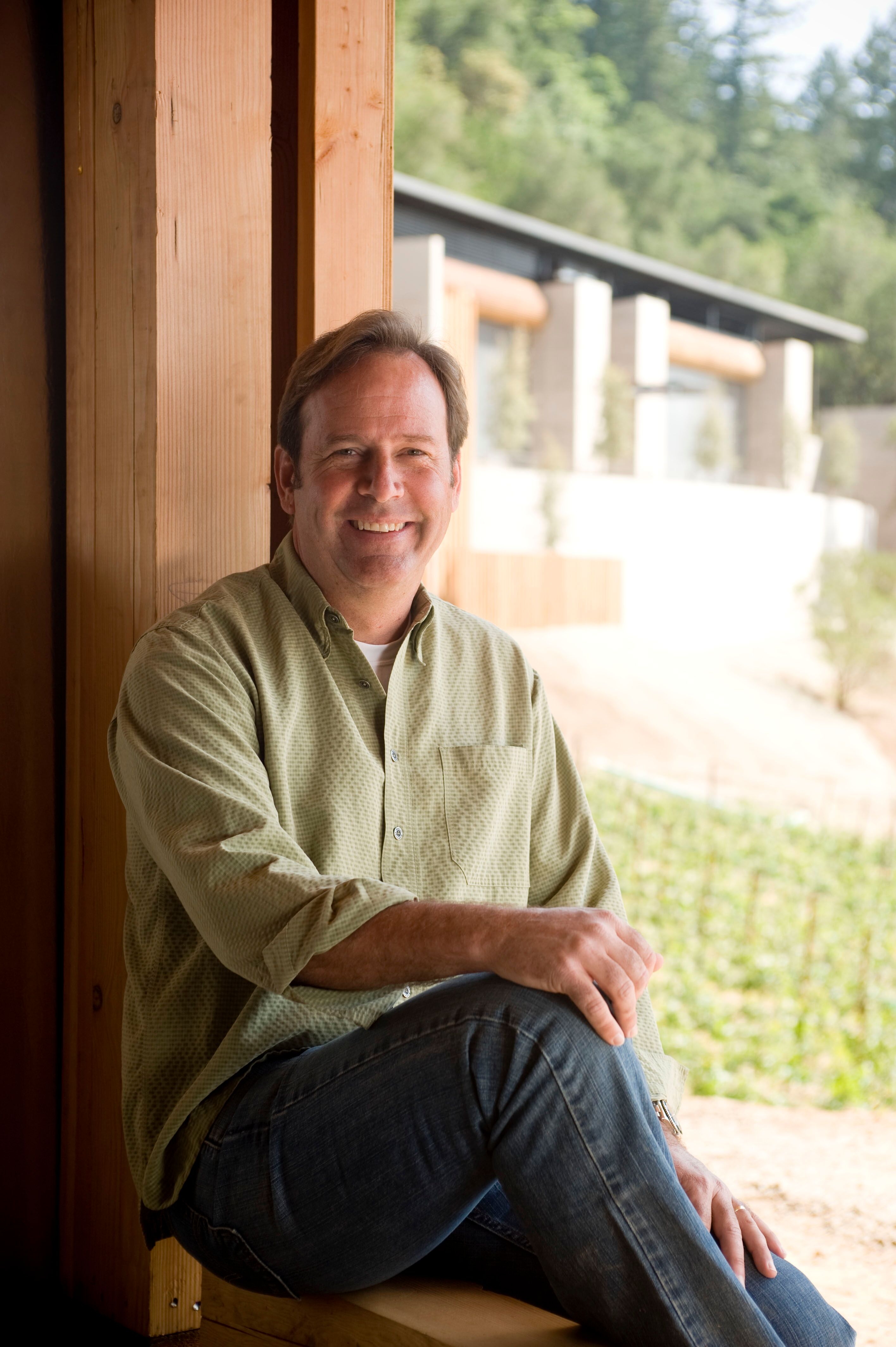 who methodically
increased production from 1,000 to 12,500 cases
annually.
In 2003 a second estate, called Cade,
was planted on 21 acres of Howell Mountain, and
in 2012 a Stags Leap District
property was purchased to become the 45-acre
Odette Estate Winery, which, like
Cade, would be designed around state-of-the-art
technology for LEED
certification, with a living green roof, 2,500
square feet of solar panels and
use of recycled shipping containers from China.
Odette now produces about the
same number of cases as PlumpJack.
who methodically
increased production from 1,000 to 12,500 cases
annually.
In 2003 a second estate, called Cade,
was planted on 21 acres of Howell Mountain, and
in 2012 a Stags Leap District
property was purchased to become the 45-acre
Odette Estate Winery, which, like
Cade, would be designed around state-of-the-art
technology for LEED
certification, with a living green roof, 2,500
square feet of solar panels and
use of recycled shipping containers from China.
Odette now produces about the
same number of cases as PlumpJack.
In
2012 Aaron Miller, previously at Lewis
Cellars, was appointed wine maker.
The PlumpJack estates began early on to garner high praise for their Cabernet Sauvignons, but it was a daring decision in 2000 for the company to replace traditional corks with the Stelvin screwcap closure on half (150 cases) of its most expensive bottling—PlumpJack's 1997 Reserve Cabernet Sauvignon ($135)—which would cost $10 per bottle more than those in the cases closed with corks.
“In 1994 UC Davis [University of California at Davis] studied screwcaps versus corks and found they were the best for every wine,” Conover said at dinner. “It just made sense to us.” The idea would not have been novel in Australia, New Zealand, South Africa, even in France, but in California the association of screwcaps with jug wines made PlumpJack’s decision shocking to some. But down deep, most of PlumpJack’s competitors knew that screwcaps were a fool-proof way to prevent the cork-caused taint trichloroanisole, which can make up to 10% of wines undrinkable.
Experimentation
has always been important to
PlumpJack, but, unlike some of their
competitors, making a wide range of
varietals was never the plan.
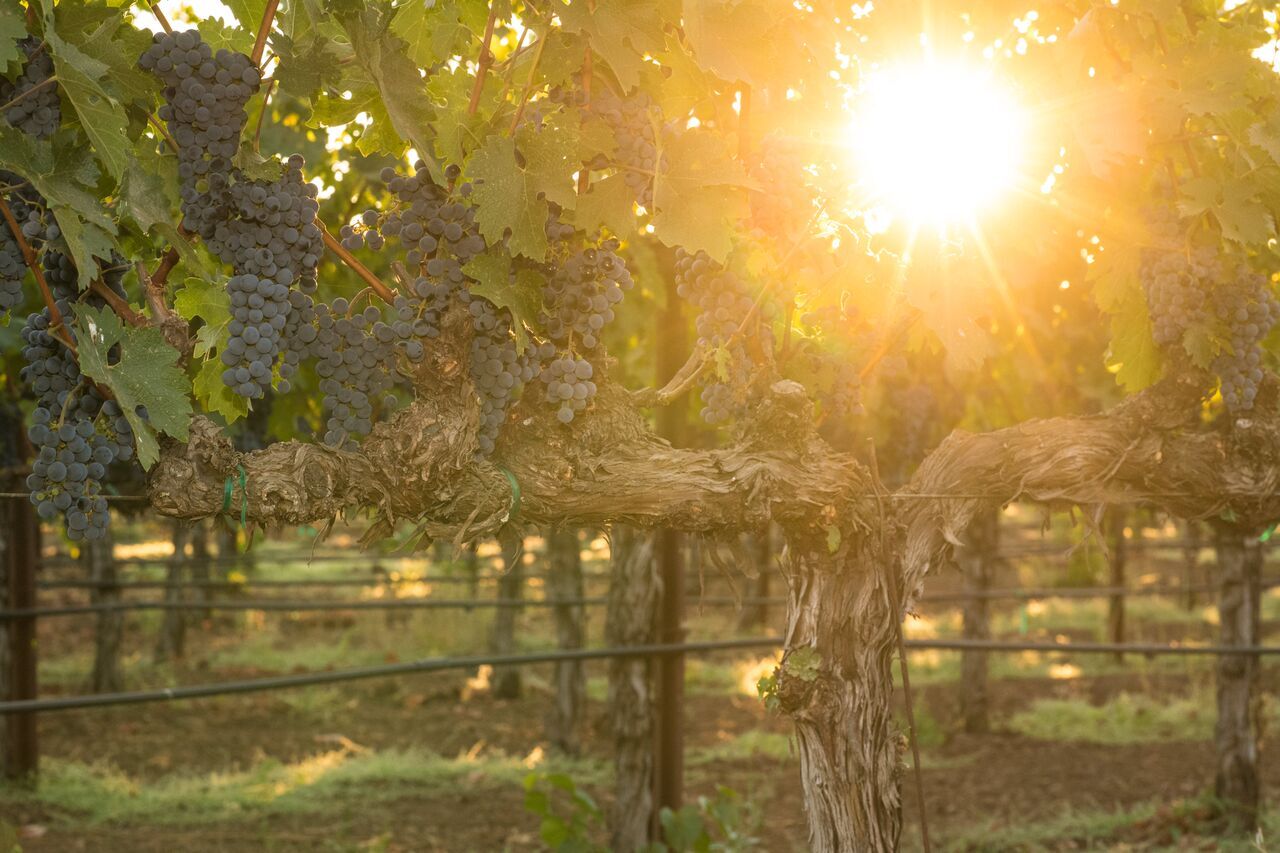 “When we started out
we were making 20 different
wines,” Conover said, “and discontinued 18 of
them the first year.”
“When we started out
we were making 20 different
wines,” Conover said, “and discontinued 18 of
them the first year.”
PlumpJack does not, however, make only the Cabs for which it is so well known. Syrah, a reserve Chardonnay and a Merlot are also in the estate’s portfolio. Odette makes Chardonnay and Petite Syrah, and Cade produces Sauvignon Blanc. They also make many of their reds in magnums, and the winery is especially canny about offering gift packages through their catalogs.
Like many of the more prestigious California
wines, 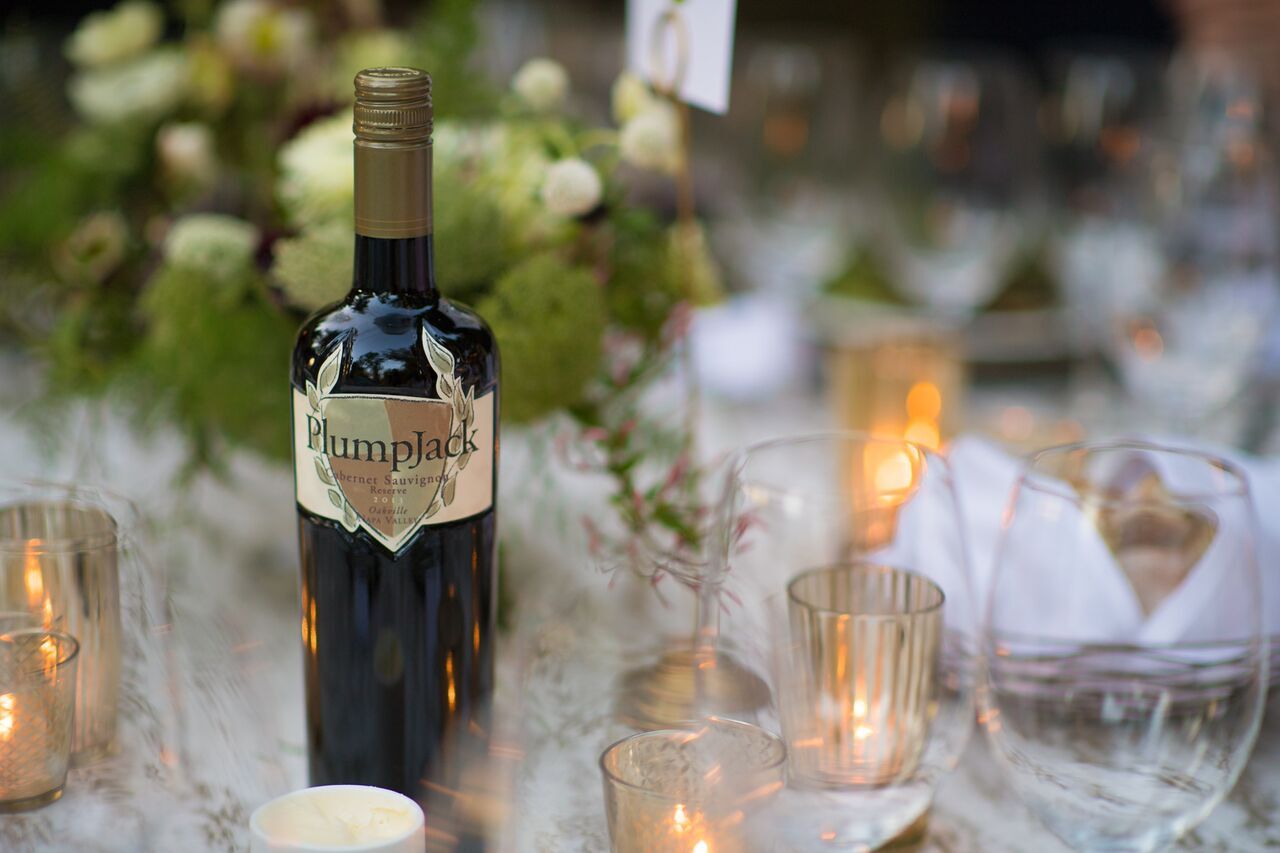 much of PlumpJack’s
production (about one-thirds) is sold by direct
shipping to regular customers; of the rest, 80%
is sold to restaurants and 20%
to wine retailers.
much of PlumpJack’s
production (about one-thirds) is sold by direct
shipping to regular customers; of the rest, 80%
is sold to restaurants and 20%
to wine retailers.
I’ve admired PlumpJack wines since they were first released, at a time when too many California Cabs were aiming to be massive fruit bombs. Not least I applauded the estate’s iterations of the various terroirs and honesty about vintages—“The 2011 vintage was a disaster with late rains in October, which threatened rot,” said Conover—though I’m not a fan of their Cabs that go north of 15% in alcohol. I suppose what I like most is the way Getty allows his own natural exuberance to be tempered by the harsh realities of an industry now in the grips of climate change and global market forces, leaving Conover to make sure they achieve a signature style that is always open to change for the better.
❖❖❖

 Senior brand manager Kriston Ohm
said, "In today’s text savvy world, many
conversations start (and end) with an emoji. By
adding an emoji design to each pip of chocolate,
we hope that parents and kids are inspired to
share a chocolate emoji and make a connection with
someone new.”
Senior brand manager Kriston Ohm
said, "In today’s text savvy world, many
conversations start (and end) with an emoji. By
adding an emoji design to each pip of chocolate,
we hope that parents and kids are inspired to
share a chocolate emoji and make a connection with
someone new.”
FUN GUYS
OF HOUSTON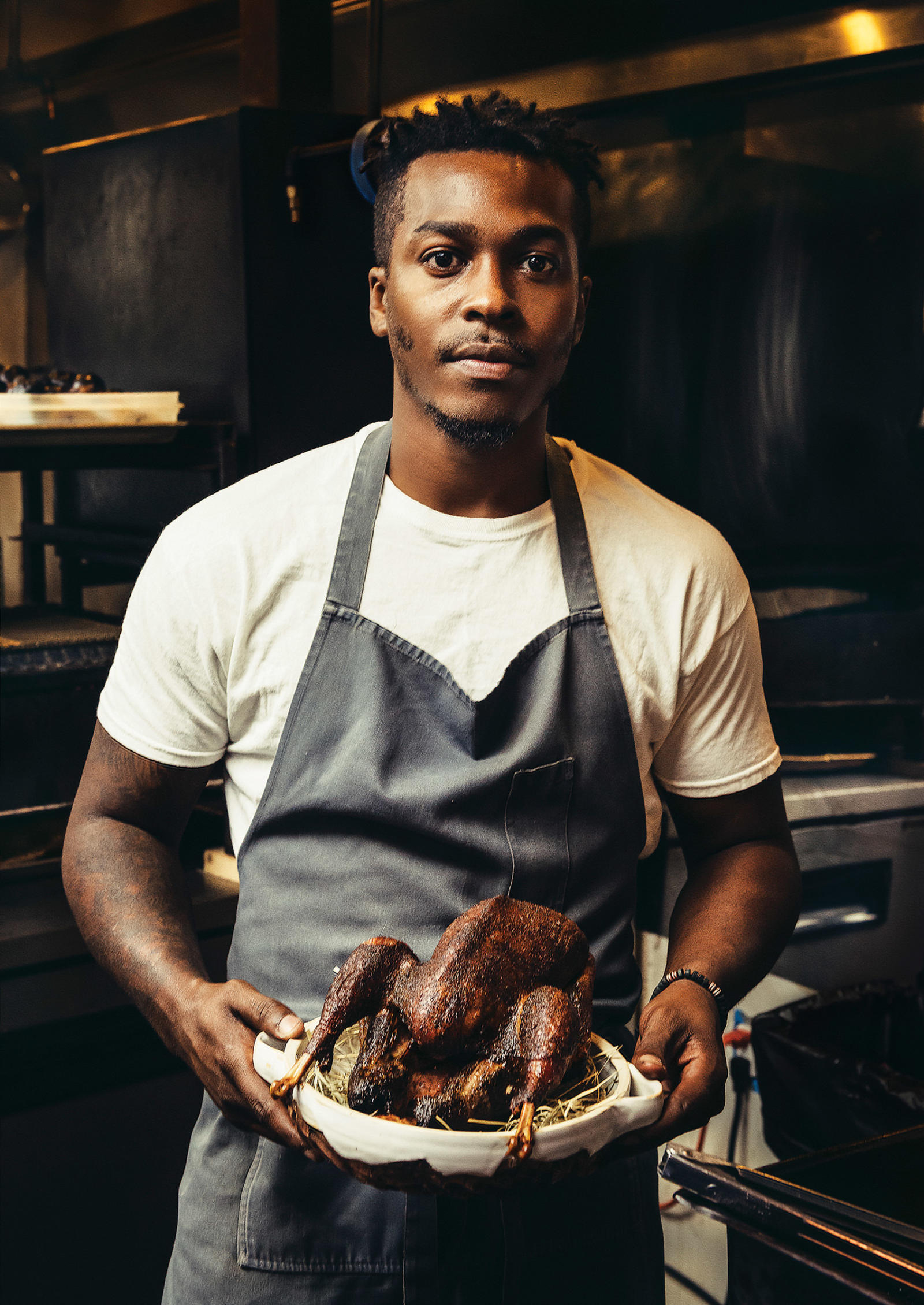
“‛Black men, as we know, have been
hyper-sexualized as a way of maintaining that
fear,’” [Jonny Rhodes of Indigo] went on. “‛And
part of that is the idea of giant, threatening
black penises.’ It occurred to me that I would
never again be able to feign interest in a
server's rap about ‛how our menu works.’ Rhodes
allowed himself only the smallest smile as the
dish was placed before us.On the
plate was an inch-long stub of dark
sausage.”—Brett Martin, “Best Restaurants 2019,” GQ (May
2019)
❖❖❖
❖❖❖
Wine
Column Sponsored by Banfi Vintners
SANGIOVESE
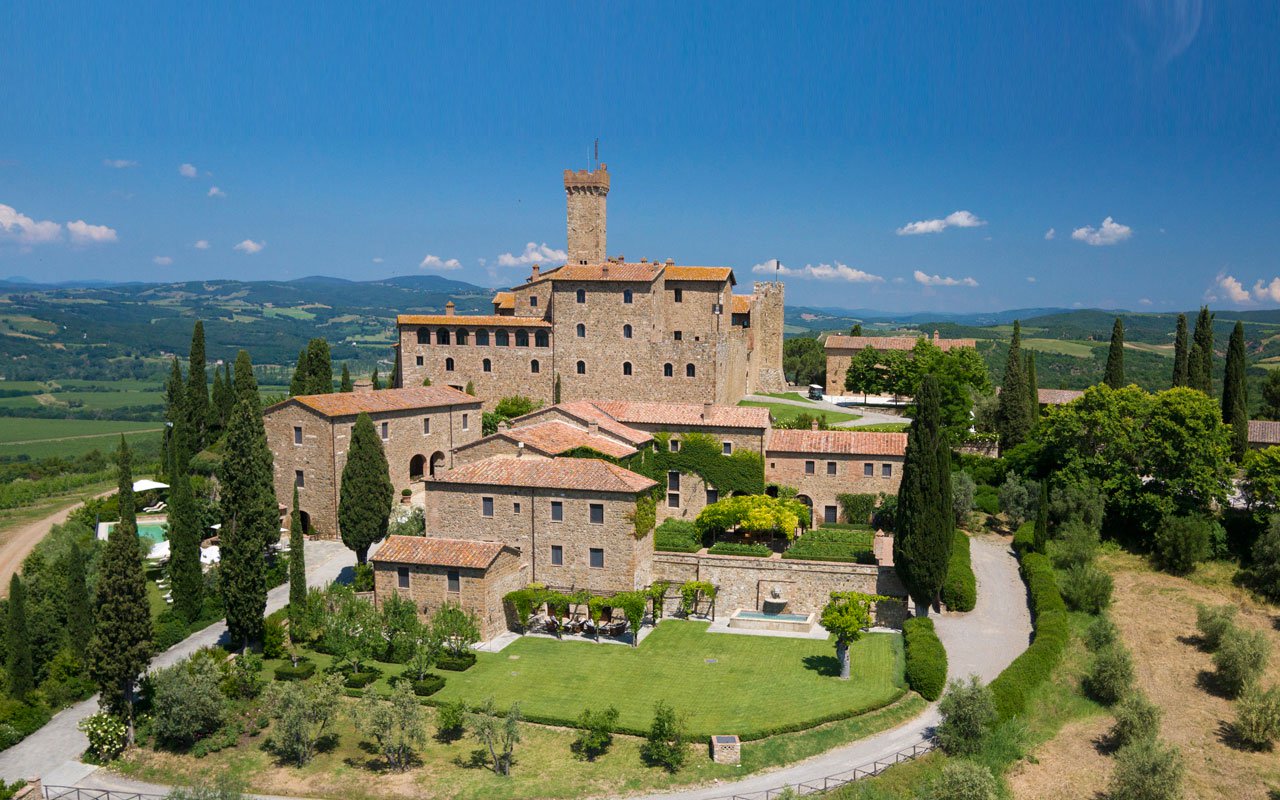 Wine is a joy year-round but
in cooler weather one
grape varietal has really taken center stage in
my daily activities – that most Italian of
grapes, Sangiovese, and its ultimate expression
– Brunello di Montalcino.
Wine is a joy year-round but
in cooler weather one
grape varietal has really taken center stage in
my daily activities – that most Italian of
grapes, Sangiovese, and its ultimate expression
– Brunello di Montalcino.
From mid-September through mid-October,
the Sangiovese grown for our various styles of red
wines are be harvested, culminating with the top
selection for Brunello di Montalcino.
Second, cooler weather here means
it is time to start enjoying more red wines and
especially Sangiovese based wines. That
includes Banfi’s cru of Brunello, Poggio alle Mura,
literally the cream of the crop of our Sangiovese
vineyards. Alongside our Poggio alle Mura Brunello di
Montalcino, this year we introduced two more wines
from the cru Poggio alle Mura – a Rosso di Montalcino
and a Riserva of Brunello. Rosso is sort of like the
younger brother of Brunello, also made from 100%
Sangiovese grapes but usually a selection from younger
vines and the wine is aged only two years compared to
the four required for Brunello. The
Riserva, on the other hand, is an even more selective
harvest of Sangiovese, and ages for an additional year
before release.
What is so special about this cru
Poggio alle Mura?
Well, it is the result our over 30 years of
ongoing research at my family’s vineyard estate,
Castello Banfi.
When we first began planting our vines there in
the late 1970s studies from the University of Bordeaux
indicated which strains of many varietals we should
plant, based on the soil type and microclimate of each
vineyard. But
when it came to the region’s native Sangiovese, there
was only local lore, no scientific research. So we took
it upon ourselves to figure out this vine, and set off
on three decades of incredibly detailed research.
We started
with 600 apparent variations on Sangiovese, because it
is so susceptible to variations in weather and soil,
and narrowed that down to 160 truly genetically
different clones.
We planted a vineyard with two rows of each
type, made wine from each of them, and charted the
differences – remember, you only get one chance a year
to make wine, so this took time.
It took about ten years to get some
concrete results, though we continue to experiment
today and always will – you never stop learning in
science and nature!
Once we determined which were the best,
complementary clones that could be planted together to
make the best Brunello, we chose to plant them in what
we determined to be the optimal vineyard sites. Coincidentally,
the best soils and climate conditions are in the
slopes surrounding the medieval fortress today known
as Castello Banfi, known since Etruscan times as
Poggio alle Mura – the walled hilltop. Hence the
name of our most special “cru” of Brunello,
representing a synthesis between tradition and
innovation.
Though the focus of this study was
our Brunello, all of our Sangiovese-based wines,
including the super Tuscans SummuS, Cum Laude, and
Centine, benefitted from this work. And that’s
the third reason for celebrating Sangiovese this
month, for the range of wonderful reds that usher us
into autumn! One
wine in particular was inspired by our research – the
BelnerO, a Sangiovese dominant blend with what I like
to call a kiss of Cabernet and a whisper of Merlot. We grow the
grapes a little differently for BelnerO than for
Brunello, make the wine with less oak aging and
released it earlier from the winery, providing a
counterpoint to Brunello and a lovely terroir-driven
wine in its own right.
If you
know Italians, you know that by nature we are
multi-faceted, varying in mood, and always passionate. As a
nation, we span from the hot sunny beaches of Sicily
near the African coast to the rugged mountains and
Alpine ski slopes of Trentino-Alto Adige in the north. Sangiovese
is grown in almost all of Italy’s regions and reflects
the unique nature of each; it is most famous
(rightfully so) in Tuscany, yet even there it reflects
the nuances of each hilltop, valley and subzone. It has
something a little different to say in Brunello than
Chianti, Morellino than Vino Nobile di Montepulciano,
Rosso di Montalcino than Super Tuscan blends.
Here is a smattering of
Sangiovese-based wines that you may wish to get to
know better, reflecting a spectrum that appeals to
every occasion, every taste, and every budget. We can
assure you that the conversation will never become
boring. 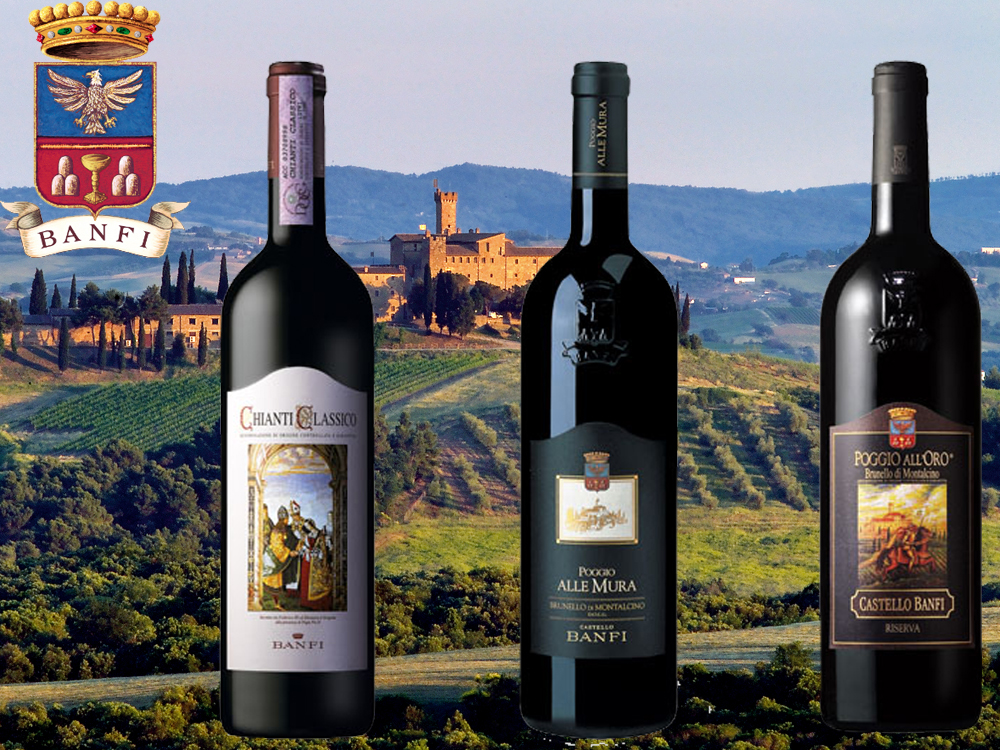
Recommendations for Celebrating
Sangiovese
BelnerO Proprietor’s Reserve Sangiovese
– A refined
cuvée of noble red grapes perfected by our pioneering
clonal research. This dark beauty, BelnerO, is
produced at our innovative winery, chosen 11
consecutive years as Italy’s Premier Vineyard Estate.
Fermented in our patented temperature controlled
French oak and aged approximately 2 additional years.
Unfiltered, and Nitrogen bottled to minimize sulfites.
Castello Banfi Brunello di Montalcino –
Rich, round, velvety and intensely
aromatic, with flavor hints of licorice, cherry, and
spices. Brunello di Montalcino possesses an intense
ruby-red color, and a depth, complexity and opulence
that is softened by an elegant, lingering aftertaste.
Unfiltered after 1998 vintage.
Castello Banfi Rosso di Montalcino – Brunello's "younger brother," produced
from select Sangiovese grapes and aged in barrique for
10 to 12 months. Deep ruby-red, elegant, vibrant,
well-balanced and stylish with a dry velvety
finish.
Poggio all’Oro Brunello di Montalcino
Riserva – A single vineyard selection of our most
historically outstanding Sangiovese, aged five years
before release, the additional year more than that
required of Brunello including 6 months in barrel and
6 months more in bottle to grant its “Riserva”
designation. Incredible
elegance and harmony. Intense with lots of fruit and
subtle wood influence. Round, complete, well balanced
with hints of chocolate and berries. Unfiltered after
1998.
Poggio alle Mura – The first tangible result of years of
intensive clonal research on Montalcino’s native
Sangiovese grape.
Estate bottled from the splendidly sun drenched
vineyards surrounding the medieval Castello from which
it takes its name.
The Brunello
di Montalcino is seductive, silky and smoky. Deep ruby
in color with an expressive bouquet of violets, fruits
and berries as well as cigar box, cedar and exotic
spices. The Rosso
di Montalcino is also intense ruby red. The bouquet
is fresh and fruity with typical varietal notes of
cherry and blackberry, enriched by more complex hints
of licorice, tobacco and hazelnut. It is full
bodied, yet with a soft structure, and a surprisingly
long finish. The Poggio alle Mura Brunello di Montalcino
Riserva is deep ruby red with garnet
reflections and a rich, ample bouquet that hints of
prune jam, coffee, cacao and a light balsamic note. It is full
and powerful, with ripe and gentle tannins that make
it velvety and harmonious; this wine is supported by a
pleasing minerality that to me speaks soundly of that
special hillside in southern Montalcino.
SummuS – A wine of towering elegance, SummuS is an
extraordinary blend of Sangiovese which contributes
body; Cabernet Sauvignon for fruit and structure; and
Syrah for elegance, character and a fruity bouquet. An elegant,
complex and harmonious red wine.
Cum Laude – A complex and elegant red which graduated
“With Honors,” characterized by aromas of juicy
berries and fresh spices.
Centine – A Cuvee that is more than half
Sangiovese, the balanced consisting of equal parts of
Cabernet Sauvignon and Merlot. Vinified in
a firm, round style that easily accompanies a wide
range of dishes, this is a smooth and fragrantly
satisfying wine with international character, and a
perennial favorite at my own dinner table.
Banfi Chianti Superiore – The “Superiore” designation signifies
stricter government regulations regarding production
and aging requirements, as compared to regular
Chianti. An
intense ruby red wine with fruit forward aromas and
floral notes. This
is a round wine with well-balanced acidity and fruit.
Banfi Chianti Classico – An enduring classic: alluring
bouquet of black fruit and violets; rich flavors of
cherry and leather; supple tannins and good acidity
for dining.
Banfi Chianti Classico Riserva – Produced from select grapes grown in the
"Classico" region of Chianti, this dry, fruity and
well-balanced red has a full bouquet reminiscent of
violets.
Fonte alla Selva Chianti Classico – This is our newest entry into the Chianti
arena, coming from a 99 acre estate in Castellina, the
heart of the Chianti Classico region. The wine is
a captivating mauve red that smells of cherry, plum
and blackberry with hints of spice. It is
round, full and balanced with very good
acidity.
Col di Sasso – Sangiovese and Cabernet Sauvignon. Luscious,
complex and soft with persistent notes of fruit and
great Italian style structure.
Any of John Mariani's books below may be ordered from amazon.com.
 The Hound in Heaven
(21st Century Lion Books) is a novella, and
for anyone who loves dogs, Christmas, romance,
inspiration, even the supernatural, I hope you'll find
this to be a treasured favorite. The story
concerns how, after a New England teacher, his wife and
their two daughters adopt a stray puppy found in their
barn in northern Maine, their lives seem full of promise.
But when tragedy strikes, their wonderful dog Lazarus and
the spirit of Christmas are the only things that may bring
his master back from the edge of despair.
The Hound in Heaven
(21st Century Lion Books) is a novella, and
for anyone who loves dogs, Christmas, romance,
inspiration, even the supernatural, I hope you'll find
this to be a treasured favorite. The story
concerns how, after a New England teacher, his wife and
their two daughters adopt a stray puppy found in their
barn in northern Maine, their lives seem full of promise.
But when tragedy strikes, their wonderful dog Lazarus and
the spirit of Christmas are the only things that may bring
his master back from the edge of despair. WATCH THE VIDEO!
“What a huge surprise turn this story took! I was completely stunned! I truly enjoyed this book and its message.” – Actress Ali MacGraw
“He had me at Page One. The amount of heart, human insight, soul searching, and deft literary strength that John Mariani pours into this airtight novella is vertigo-inducing. Perhaps ‘wow’ would be the best comment.” – James Dalessandro, author of Bohemian Heart and 1906.
“John Mariani’s Hound in Heaven starts with a well-painted portrayal of an American family, along with the requisite dog. A surprise event flips the action of the novel and captures us for a voyage leading to a hopeful and heart-warming message. A page turning, one sitting read, it’s the perfect antidote for the winter and promotion of holiday celebration.” – Ann Pearlman, author of The Christmas Cookie Club and A Gift for my Sister.
“John Mariani’s concise, achingly beautiful novella pulls a literary rabbit out of a hat – a mash-up of the cosmic and the intimate, the tragic and the heart-warming – a Christmas tale for all ages, and all faiths. Read it to your children, read it to yourself… but read it. Early and often. Highly recommended.” – Jay Bonansinga, New York Times bestselling author of Pinkerton’s War, The Sinking of The Eastland, and The Walking Dead: The Road To Woodbury.
“Amazing things happen when you open your heart to an animal. The Hound in Heaven delivers a powerful story of healing that is forged in the spiritual relationship between a man and his best friend. The book brings a message of hope that can enrich our images of family, love, and loss.” – Dr. Barbara Royal, author of The Royal Treatment.
 |
The Encyclopedia of American Food and Drink by John F. Mariani (Bloomsbury USA, $35) Modesty forbids me to praise my own new book, but let me proudly say that it is an extensive revision of the 4th edition that appeared more than a decade ago, before locavores, molecular cuisine, modernist cuisine, the Food Network and so much more, now included. Word origins have been completely updated, as have per capita consumption and production stats. Most important, for the first time since publication in the 1980s, the book includes more than 100 biographies of Americans who have changed the way we cook, eat and drink -- from Fannie Farmer and Julia Child to Robert Mondavi and Thomas Keller. "This book is amazing! It has entries for everything from `abalone' to `zwieback,' plus more than 500 recipes for classic American dishes and drinks."--Devra First, The Boston Globe. "Much needed in any kitchen library."--Bon Appetit. |
"Eating Italian will never be the same after reading John Mariani's entertaining and savory gastronomical history of the cuisine of Italy and how it won over appetites worldwide. . . . This book is such a tasteful narrative that it will literally make you hungry for Italian food and arouse your appetite for gastronomical history."--Don Oldenburg, USA Today. "Italian
restaurants--some good, some glitzy--far
outnumber their French rivals. Many of
these establishments are zestfully described
in How Italian Food Conquered the World, an
entertaining and fact-filled chronicle by
food-and-wine correspondent John F.
Mariani."--Aram Bakshian Jr., Wall Street
Journal.
"Equal parts
history, sociology, gastronomy, and just
plain fun, How Italian Food Conquered the
World tells the captivating and delicious
story of the (let's face it) everybody's
favorite cuisine with clarity, verve and
more than one surprise."--Colman Andrews,
editorial director of The Daily
Meal.com. "A fantastic and fascinating
read, covering everything from the influence
of Venice's spice trade to the impact of
Italian immigrants in America and the
evolution of alta cucina. This book will
serve as a terrific resource to anyone
interested in the real story of Italian
food."--Mary Ann Esposito, host of PBS-TV's
Ciao
Italia. "John Mariani has written the
definitive history of how Italians won their
way into our hearts, minds, and
stomachs. It's a story of pleasure over
pomp and taste over technique."--Danny Meyer,
owner of NYC restaurants Union Square
Cafe, The Modern, and Maialino.
|
 |
 |
 |
 |
 |
 |
 |
 |
 Everett Potter's Travel Report:
Everett Potter's Travel Report: 
 Eating Las Vegas
JOHN CURTAS has been covering the Las Vegas
food and restaurant scene since 1995. He is
the co-author of EATING LAS VEGAS – The 50
Essential Restaurants (as well as
the author of the Eating Las Vegas web site: www.eatinglasvegas.
He can also be seen every Friday morning as
the “resident foodie” for Wake Up With the
Wagners on KSNV TV (NBC) Channel 3 in
Las Vegas.
Eating Las Vegas
JOHN CURTAS has been covering the Las Vegas
food and restaurant scene since 1995. He is
the co-author of EATING LAS VEGAS – The 50
Essential Restaurants (as well as
the author of the Eating Las Vegas web site: www.eatinglasvegas.
He can also be seen every Friday morning as
the “resident foodie” for Wake Up With the
Wagners on KSNV TV (NBC) Channel 3 in
Las Vegas.
MARIANI'S VIRTUAL GOURMET
NEWSLETTER is published weekly. Publisher: John Mariani. Editor: Walter Bagley. Contributing Writers: Christopher Mariani,
Robert Mariani, Misha Mariani, John A. Curtas, Gerry Dawes, Geoff Kalish,
and Brian Freedman. Contributing
Photographer: Galina Dargery. Technical
Advisor: Gerry
McLoughlin.
If you wish to subscribe to this
newsletter, please click here: http://www.johnmariani.com/subscribe/index.html
© copyright John Mariani 2019

